- NLI Research Institute >
- Japanese Automakers Struggle in Europe
Japanese Automakers Struggle in Europe
Mashu Kato
Font size
- S
- M
- L
(1) Japanese Automakers Struggle
For Japanese automakers, competition has proved to be more intense in Europe than in Japan or North America. Their market share improved slightly in 1996 has still declined from 12.3% in 1991 to 10.8%, the same level as 1985, due partly to exchange rates. Indications are that the hard times are not over, and their profit and sales have yet to justify their investment.
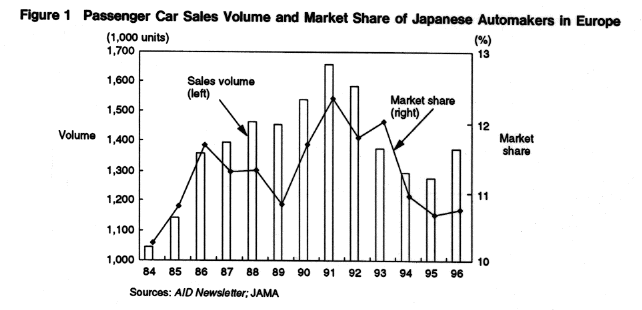
This can be attributed to two major factors:
- decline in relative price competitiveness due to the yen's surge from 1993 to 1995, and to the entry of Korean atuomakers;
- improved quality of European cars (especially manufacturing quality with respect to durability).
In particular, quality improvements can be attributed not only to the efforts of European automakers, but to the development of local venders by Japanese automakers, and to local production by Japanese parts suppliers. Since 1990, European automakers have closed the quality gap with Japanese and other Asian automakers, and have attained the same level as Ford.
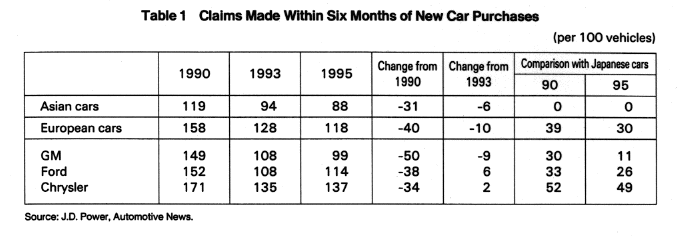
With regard to design quality as well, European automakers have accumulated substantial expertise and competitiveness because Europe has traditionally been a market for smaller cars and a history spanning over one century. This is substantiated by the popularity in Japan of the Volkswagen Golf and Polo, Opel Colsa, and Peugeot 306.
On the other hand, Japanese automakers have yet to build clear brand names and product concepts in the European market. One factor that troubles Japanese automakers is the selection criteria among European car buyers is not based on economy and performance as in North America, but on brand image and individuality.
In other words, Japanese automakers in Europe are struggling due to a relative decline in price competitiveness, the improving product quality of competitors, and weakness in design and brand image.
(2) Trends of the European Market
Except for Nissan, Japanese automakers have not established clear strategies regarding the two major trends expected in the European market: smaller cars and diesel engines. Behind these trends are environmental issues. Europe is highly aware of global warming issues, which ironically has benefited Japanese air-conditioner makers. Furthermore, the main target of emission is carbon dioxide, the nitrogen oxide emitted from diesel engines is not regarded as a problem. Thus recent years have seen increasing demand for low fuel consumption, which is achieved by smaller cars that emit less carbon dioxide, and diesel engines.
1. Shift to Smaller Cars
Many European automakers are planning to introduce new models in the sub-B segment rather than in the existing segment B. Ford Europe has already introduced models, and Japanese makers, considering their future presence in Europe, cannot afford to ignore this segment. Thus Japanese makers are under pressure to work out a strategy for the 21st century including local production, which will likely affect their competitive position not only in Europe but in global markets. Mercedes-Benz and other European automakers have worked desperately on developing small ”3-liter cars” (fuel-efficient cars that can run 100 kilometers on three liters of fuel), and are apparently nearing low-cost commercialization.
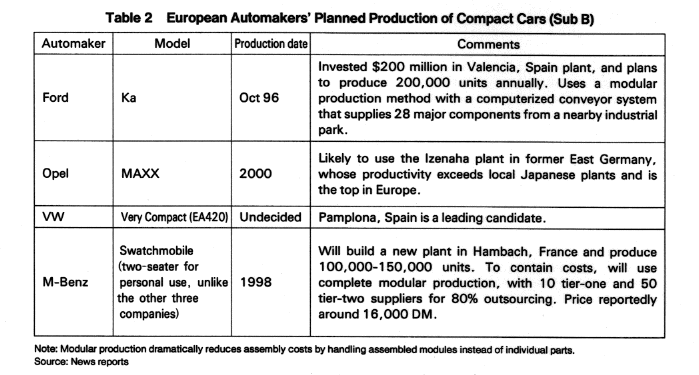
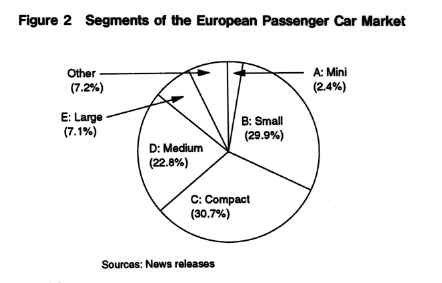

European automakers keenly feel that their existence depends on being in harmony with society's concerns over the environment. This is driving them to pursue low-cost production of unprofitable small cars through radical modularization (see note under Table 2). Experimental production is underway in low-cost locations. Modularization is intended to overhaul the production process by standardizing modular components, converting materials, and modifying and reducing processes, thereby dramatically cutting costs.
By comparison, Japanese models in segment B such as the Starlet and March are largely intended to attract first-time buyers who will develop brand loyalty, with less importance placed on profitability. Thus there is concern that cost differentials will emerge between Japanese and European automakers. Considering that the ratio of small cars is steadily growing, Japanese automakers are hard-pressed to formulate a small-car strategy that also takes local production into account.
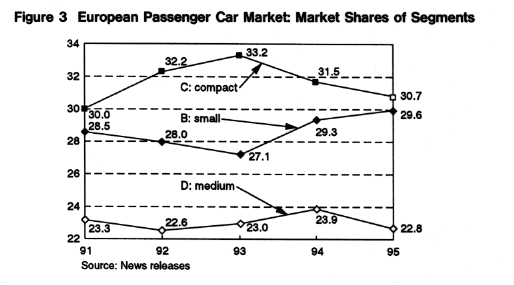
2. Shift to Diesel Engines
There is a strongly rooted demand in Europe for diesel engines owing to their low-cost maintenance and environmental policies that emphasize carbon dioxide emissions. In France, 46.5% (1995) of passenger cars have diesel engines. AID, a market research company, predicts that the percentage for the overall European market will increase from 22.3% (2.65 million units) in 1995 to 30% (4.3 million units) by 2004. This rapid growth in the ratio of diesel passenger cars poses an obstacle to Japanese automakers trying to expand their presence in Europe, and an immediate response is needed.
However, the biggest hurdle in manufacturing diesel engines for small passenger cars (under 1500 cc) is economy of scale. This is because this type of engine is needed only for the European market, while development and manufacturing costs are huge.
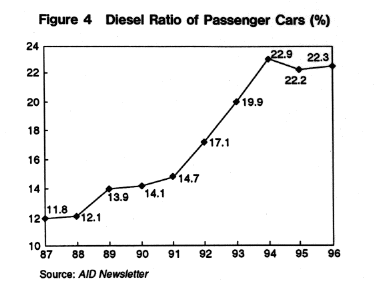
Japanese automakers have at best only niche markets in Europe. The three largest automakers each has less than a 3% market share, compared to 5% market shares in North America. Small diesel engines are not needed in the North American market, and nearly unthinkable for passenger cars in Japan due to the resolved problem of NOx particulates. Thus Honda has begun OEM procurements from Rover, and Nissan plans to do so from Peugeot for the Micra (March). Other Japanese automakers are expected to follow suite with their European counterparts.
2. Issues and Strategies of Japanese Automakers
Planned production in Europe for 2000 by Japanese automakers is quite restrained compared to North America's 3 million units and the ASEAN market's planned production capacity of 2.5 million units.
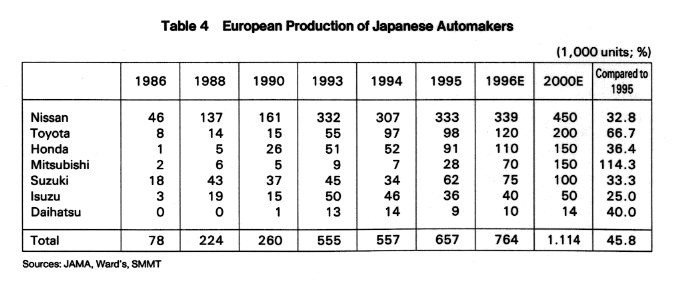
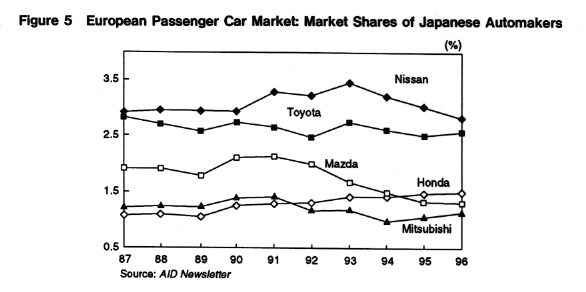
(1) Nissan
Nissan was the first Japanese automaker to begin local production in the early 1980s, and has maintained a leadership role. However, its recent performance in Europe has been disappointing, with massive after-tax losses of 60 billion yen in 1995 and 45 billion yen in 1996. Nissan has thus started restructuring to change its main focus from expanding volume to improving performance. Measures include 120 billion yen in new investments in its European subsidiary (1995 and 1996), reduced incentive programs, limited selection of models to improve inventory efficiency and reduce distribution costs, and price increases that may hurt sales volume in regions with poor profitability. Nissan aims to reduce its sales breakeven point by 100,000 units from the 1992 peak to 450,000 units (including commercial vehicles).
In addition, to increase capacity utilization rates, it is harnessing production bases in the U.K. and Spain for export outside of Europe. With a scheme of producing the Micra (March) and Primera in the U.K. for export to Australia and Taiwan, and commercial vehicles made in Spain to the Middle East and Africa. Nissan plans to further boost its U.K. production by transferring production of the Almera (Pulsar, 100,000 units annually) in 2000.
These measures are seen as a response to the shift to smaller cars in the European market by reducing costs through local production, and building development (particularly design), production, and distribution systems that respond swiftly to market changes. The proportion of locally produced cars in Nissan's European sales is expected to increase from the present 70% to 90%, thereby greatly reducing exposure to exchange rate risks.
A key to rebuilding its European base is how thoroughly it can pursue profitability over market share. Emphasizing profitability may cost Nissan its top position among Japanese automakers to market share-oriented Toyota. However, if Nissan is drawn into the fierce battle over incentives−more pronounced than in the Japanese and U.S. markets--it would hinder any improvement to profitability.
Nissan has already carried out measures to further localize small car production and incorporate diesel engines. To reverse the decline in capacity utilization rates and market share, it will need to improve the attractiveness of its products, including imports from Japan, as well as its brand image.
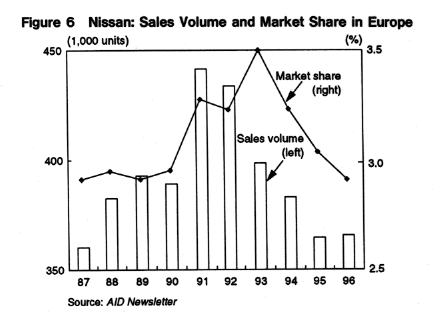
(2) Toyota
In contrast to Nissan, Toyota is concentrating on expanding market share. In 1997, Toyota aims to increase sales by 5% to 430,000 units by increasing supply of the Starlet, RAV4, Picnic (called the Ipsam in Japan), and Colorado (Land Cruiser). Doing so would put Toyota within range of challenging Nissan's lead in Europe (433,000 units in 1996). In addition, in 1998 Toyota plans to double its production capacity in the U.K. to 200,000 units, adding the Corolla class (segment C) to the present Carina E (Corona, segment D), and aim for sales of 600,000 units in 2000.
Like Nissan, Toyota is building up its U.K. production base to export from Europe. It exports the Carina E to Africa, the Middle East, and Latin America, as well as a five-door model to Japan.
The key to increasing sales to 600,000 units and establishing a stable profit base lies in focusing on cars that are smaller than the Corolla−segment A (the Renault Twingo and Fiat Chinkechent class) and segment B (Micra and Starlet class)−and on small diesel engines (with displacements below 1500 cc). Presently, in these classes, Toyota is exporting the Starlet but does not have a diesel model. Local production will be inevitable in the future, and due to the competitive edge of European makers, Toyota will need to rely on not only its strengths in cost and manufacturing quality (durability), but improve design quality as well. Reaching its sales target will also require establishing new production sites and making OEM procurement of engines and other power train components.
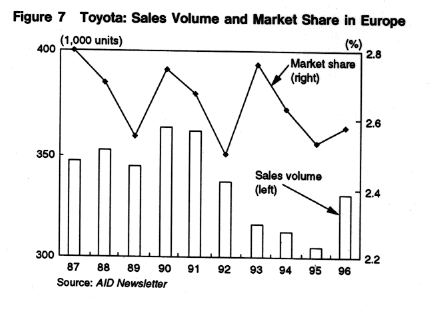
(3) Honda
When Rover became affiliated with BMW in May 1994, Honda withdrew its stake in Rover and began building its own independent base in Europe. Because of its successful and high profile participation in F1 racing since the 1960s, Honda had been the exception among Japanese automakers in having a clear brand image in Europe. While it has surpassed latecomers Mazda and Mitsubishi in passenger car sales volume, it remains far behind both Nissan and Toyota.
Honda plans to boost its U.K. production to 150,000 units in 1998 and 200,000 units in 2000, bringing annual sales up to 300,000 units by importing the remainder. At the same time, it will accelerate localization by raising local content beyond the already high 90% to avoid exchange rate risks, and gradually converting the Accord and Civic to local specifications for the European market from 1998.
The key point is whether Honda will introduce models in segments A and B, which are smaller than the present Civic and expected to comprise a growing portion of the European market. After discontinuing the mutually complementary tie-up with Rover, Honda has no entries in these segments. Honda's performance in these segments will affect the attainment of its 300,000-unit sales goal and independent position in Europe.
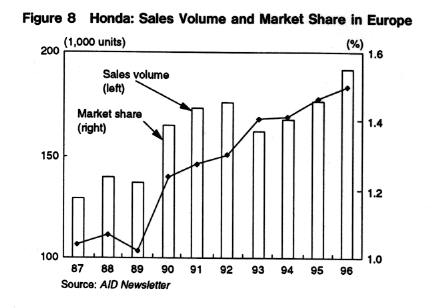
(4) Mitsubishi
Mitsubishi has been expanding its presence recently in Europe. Ned Car of the Netherlands, a joint venture with Volvo, has shown strong results in production and sales since starting up in 1995. By the fall of 1998, Ned Car, who produces the Carisma (Galanbase) and will increase its production capacity to 300,000 units, plans to introduce a small multi-purpose car in 1999 by consigning production to Pininfarina in Italy. By 2000, it aims to boost local production to account for 50% of total sales.
Through its comprehensive tie-up with Volvo, Mitsubishi plans to double its truck production capacity in Portugal to 20,000 units, increase local content to 60%, and begin OEM supply. Like other Japanese automakers, Mitsubishi aims to use Europe as an export base to the Middle East and other areas, and has begun exporting the Carisma to Japan and Taiwan. Like Honda, for Mitsubishi to make its European production profitable and autonomous, it will need to introduce models smaller than the Lancer in segments A and B, and respond to the growing demand for small diesel passenger cars.
Mitsubishi's European strategy is similar to its strategy in Asia−avoiding unnecessary risks of working alone in new markets by cooperating with local partners. Attention will be focused in the future on how well it builds on its strategic alliances and can translate them into business results.
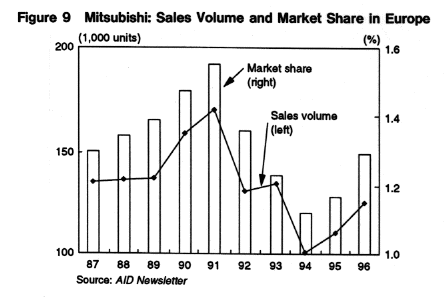
Mashu Kato
Research field
レポート紹介
-
研究領域
-
経済
-
金融・為替
-
資産運用・資産形成
-
年金
-
社会保障制度
-
保険
-
不動産
-
経営・ビジネス
-
暮らし
-
ジェロントロジー(高齢社会総合研究)
-
医療・介護・健康・ヘルスケア
-
政策提言
-
-
注目テーマ・キーワード
-
統計・指標・重要イベント
-
媒体
- アクセスランキング

















